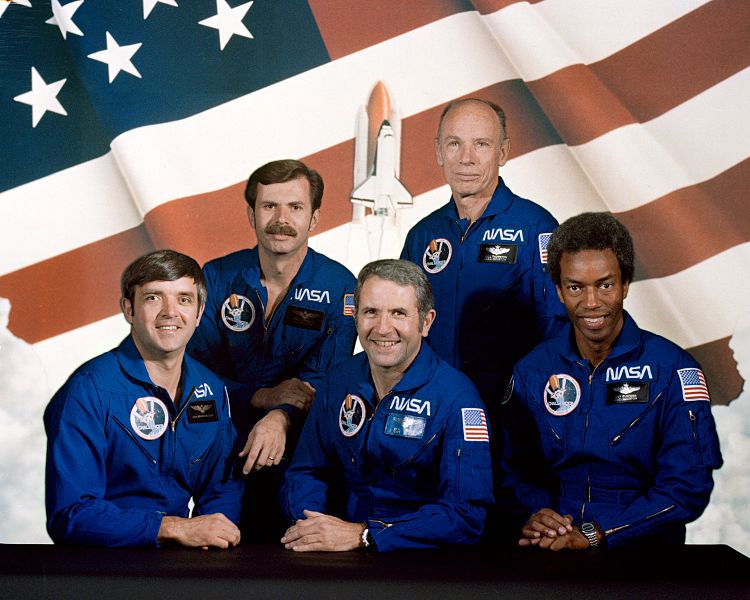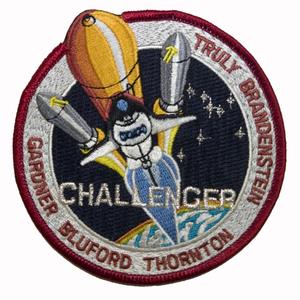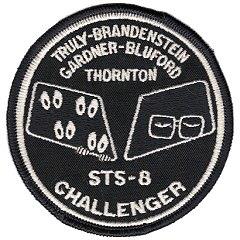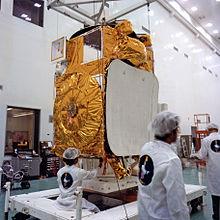Richard H. Truly
(Second Space Flight)
Daniel C. Brandenstein
(First Space Flight) Mission Specialist 1:
Dale A. Gardner
(First Space Flight) Mission Specialist 2:
Guion S. Bluford Jr.
(First Space Flight) Mission Specialist 3:
William E. Thornon
(First Space Flight)
STS-8 was a NASA Space Shuttle mission which launched on 30 August 1983 and landed on 5 September; it conducted the first night launch and night landing of the program, and flew the first African-American astronaut, Guion Bluford. The mission was a notable success, achieving all of its planned research objectives, but was marred by the subsequent discovery that a solid-fuel rocket booster had almost malfunctioned catastrophically during the launch. STS-8 was the eighth Shuttle mission and the third flight of the Space Shuttle Challenger.
The primary payload was INSAT-1B, an Indian communication and weather observation satellite, which was released by the orbiter and boosted into a geostationary orbit. The secondary payload, replacing a delayed NASA communications satellite, was a four-metric-ton dummy payload, intended to test the use of the shuttle's "Canadarm" remote manipulator system. Scientific experiments carried on board Challenger included the environmental testing of new hardware and materials designed for future spacecraft, the study of biological materials in electric fields under microgravity, and research into space adaptation syndrome (also known as "space sickness"). The flight furthermore served as shakedown testing for the previously launched TDRS-1 satellite, which would be required to support the subsequent STS-9 mission.

Command Pilot:
Astronauts:
The Space Shuttle Missions
STS-8
Pilot:
Study
Research
Main Index
Space Cosmology
Science Research
*
About
Science Research
Science Theories
Desk
Site Map
BookShelf
Copyright © by Nigel G Wilcox · All Rights reserved · E-Mail: ngwilcox100@gmail.com
Designed by Nigel G Wilcox
Powered By AM3L1A
Pages within this section: USA Shuttle Mission Flights
STS-8
Pages within this section:
1
M
8
SM
Sub-Menu
menu
2
3
4
5
6
7
8
9
INSAT-1B being prepared in a processing facility
Four Getaway Special payloads were carried. One studied the effects of cosmic rays on electronic equipment. The second studied the effect of the gas environment around the orbiter using ultraviolet absorption measurements, as a precursor to ultraviolet equipment being designed for Spacelab 2. A third, sponsored by the Japanese Asahi Shimbun newspaper, tried to use water vapor in two tanks to create snow crystals. This was a second attempt at an experiment first flown on STS-6, which had had to be redesigned after the water in the tanks froze solid. The last was similar to an experiment flown on STS-3, and studied the ambient levels of atomic oxygen by measuring the rates at which small carbon and osmium wafers oxidized.
The mission, in cooperation with the United States Postal Service, also carried 260,000 postal covers franked with $9.35 express postage stamps, which were to be sold to collectors, with the profits divided between the USPS and NASA. Two storage boxes were attached to the DFI pallet, with more stored in six of the Getaway Special canisters.
A number of other experiments were to be performed inside the orbiter crew compartment. Among these was the Continuous Flow Electrophoresis System, being flown for the fourth time. This separated solutions of biological materials by passing electric fields through them; the experiment aimed at supporting research into diabetes treatments. A small animal cage was flown containing six rats; no animal experiment was carried out on the flight, but a student involvement project was planned for a later mission which would use the cage, and NASA wanted to ensure it was flight-tested. The student involvement project carried out on STS-8 involved William Thornton using biofeedback techniques, to try to determine if they worked in microgravity. A photography experiment would attempt to study the spectrum of a luminous atmospheric glow which had been reported around the orbiter, and determine how this interacted with firings of the reaction control system.


Data Courtesy Wikipedia.org














